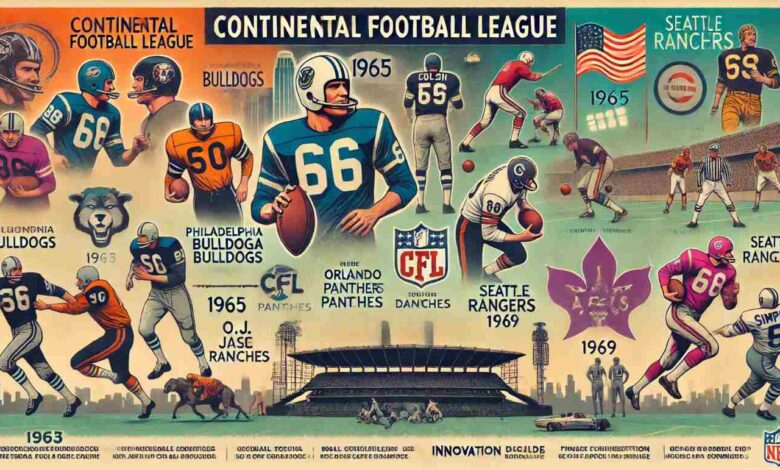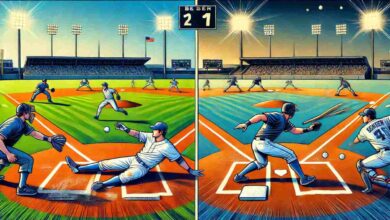The History of COFL (Continental Football League)

The Continental Football League (COFL), though short-lived, was an important chapter in the development of professional American football. Founded in 1965, it aimed to be a major player outside the realm of the NFL and AFL, but its ambitions were thwarted by various challenges, leading to its eventual dissolution in 1969. In this article, we’ll dive into the rise and fall of the COFL, its teams, notable players, and the legacy it left behind.
The Formation of the COFL
The Continental Football League was announced in February 1965, as a “minor league” developed to fill the gaps within the established NFL and AFL. Teams in the league predominantly come from markets where local football is played and minor professional teams that previously participated in either the United Football League (UFL) or other small professional leagues.
The COFL was born with claims for professionalism; standardized rules, 36-men rosters, and a 5-man “taxi” squad an NFL concept. The COFL was not shy about its ambitions, even while focusing on the smaller market of pro football. The league branded itself as a place for teams that were untouched or underappreciated beyond the AFL-NFL duopoly and were expected to play in markets that these two leagues had not yet breached.
Among the innovations that it introduced and not all of them would be instantly adopted (such as sudden-death overtime to break ties, still a rarity in NFL regular-season play) was the Friday-night special. These decisions indicated that the COFL was willing to test limits itself and be different.
Early Success and Expansion
The COFL began with franchises predominantly in the Eastern United States and Midwest, but as seen here it stretched coast to coast. Franchises such as the Philadelphia Bulldogs, Orlando Panthers, and Toronto Rifles would begin to define that league. In the next few seasons, the COFL expanded to have national regional divisions and also added striking teams in Western states.
The COFL adapted by creating a Pacific Division first in 1967, incorporating franchises from the “continental” Pacific Football League, such as the Eugene Bombers, Seattle Rangers, and Victoria Steelers. Fans were excited about the expansion, and support in a few cities was strong.
Cities such as Orlando and Indianapolis, for example, managed to attract decent interest. Still, despite these positives, the COFL was having trouble gaining significant traction across the nation — a hurdle that in the end would be its undoing.
Players and Coaches
The league attracted a blend of young talent and ex-pros who wanted to play again. Among the most well-known were Bob Broadhead, who shared team MVP honors in 1965, and Bill Walsh, a coach for the San Jose Apaches of 1967, before taking over as head man in San Francisco, leading them to multiple Super Bowl victories.
The league even had aspirations of bringing superstar O.J. Simpson to the COFL in 1969. For the COFL, however, they were awarded but quickly outbid by the newly merged AFL-NFL, showing that while there was talent in the COFL, it could not keep up with its bigger counterparts.
Challenges and the Decline
Although it had some on-field success, the COFL encountered major off-field problems. Without the benefit of a regular television contract, growth was stunted. Shortly after, the COFL entered into a deal with United Network to televise games but folded when the network did before any games were broadcast, a disastrous blow for exposure required to grow a fan base. Also, franchises were again unstable.
Teams came and folded frequently, such as the Toronto Rifles which was forced to fold in mid-season after poaching players by the Canadian Football League. Many teams struggled due to financial problems.
Such poorly planned franchises as the Akron Vulcans, dust storms and all, folded in just a matter of games back in 1967 with other teams having to pick up their unpaid salary tab. But with the league financially unstable and ownership enthusiasm waning by this point not to mention corporate sponsors looking elsewhere for partnerships to bestow their marketing budgets upon then things really began to fall apart.
The Merger Attempts
In a move to stabilize, the COFL merged with the Professional Football League of America (PFLA) in 1969, adding a Central Division which included teams such as the Omaha Mustangs. In addition, the league took in the Texas Professional Football League. The idea behind these moves was to strengthen the COFL, bringing in new viewers and additional financial support.
The COFL’s last-ditch effort to survive was in signing superstar player O.J. Simpson but lost out to the wealthier AFL-NFL merger. The fall of the COFL snowballed after more teams folded, unable to compete with the larger, better-established leagues.
The Legacy of the COFL
The league had disbanded by 1969, with some teams joining other minor leagues or ceasing operations. As short as the league has lived, its influence on football especially in some secondary markets of the United States — has been significant. But the COFL gave a chance to players, coaches, and cities that weren’t likely going to be seen in the big leagues.
The AFL also led to the advent of innovation, such as sudden-death overtime and promoting football in markets not previously colonized. The COFL also opened up the door for an eventual expansion of football leagues. Its ideas and concepts, such as targeting small markets and establishing non-traditional football rules, will later be utilized by leagues including the World Football League (WFL) and United States Football League (USFL).
The COFL colluded with the PFLA for a while, which became an early harbinger of professional sports league mergers to come.
The Bottom Line
The COFL may not have been as successful as it was hoped, but is still carved in the game. It still stands as a beacon of hope and creativity in a game long-since overrun by massive leagues. It petered out amid financial woes and from being run off the road by better-funded competition from the AFL and NFL but it existed long enough to preventarily embed itself into the memory of those who recall its all-too-brief though fun heyday. But its legend remains enshrined in football lore as a testament to the ever-changing nature of professional sport.





